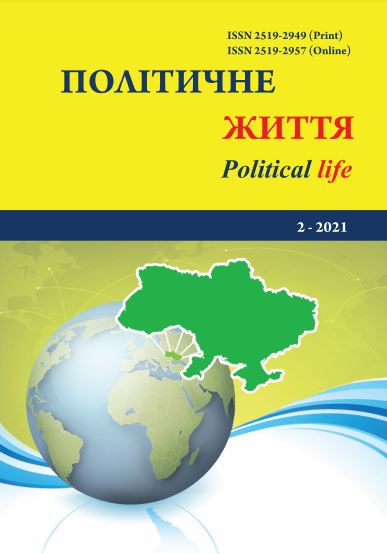Donbass as an Object of de-Ukrainization of the Adherents of the «Russian World»
DOI:
https://doi.org/10.31558/2519-2949.2021.2.13Keywords:
hybrid war; de-Ukrainization; identity; visual propaganda; ideological occupationAbstract
The purpose of the article is to try to understand the phenomenon of the ideological component of Russian hybrid aggression, to investigate how an alternative reality is formed in the occupied territories, built by the Kremlin whose main goal is the total Ukrainization of the region. of Donetsk and Luhansk regions through various sources. An important role in shaping the anti-Ukrainian identity of the population of the occupied Donbass was given to visual propaganda. The ideological treatment of the population of the «people's republics» is based on a centralized system of information space management. The authors note that the focus of both Russian and local political technologists and power structures of the «people's republics» remains the promotion of the concept of «special Donbass identity», the use of prepared facts of events, which contributes to further de-Ukrainization of the region. Instead of the history of Ukraine, the so-called «history of the Motherland» has appeared in the educational institutions of the «people's republics», in which the history of the region is combined with the history of Russia. A new educational subject has appeared in the curricula of educational institutions – «lessons of citizenship of Donbass». The content of this course is based on the narratives of Russian propaganda and aims to deprive children and young people of historical memory. There is an integration with the Russian educational space. Conclusions: Thus, the information and propaganda component of the conflict in Donbass is one of the most important tools for leveling the all-Ukrainian identity in this region. The ideological occupation of Donbass is carried out, first of all, through the promotion of the idea of non-Ukrainian identity of the population of the region. Practical meaning: the main provisions can be used to study the history of the occupation of the Donbass region. Originality: features of the hybrid Russian-Ukrainian war, namely its virtual component is covered. Scientific novelty: for the first time an attempt was made to conduct a comprehensive study of the ideological occupation of Donbass by Russia.
References
Війна на Донбасі: реалії і перспективи врегулювання. Національна безпека і оборона.. Київ, 2019. Вип.01–02 (177–178). С.2 – 172.
Березовець Т. Анексія: Острів Крим. Хроніки «гібридної війни». Київ: Брайт Стар Паблишинг, 2015. 392 с.
Брехуненко В. Війна за свідомість. Російські міфи про Україну та її минуле. Київ: Видавець Брехуненко Н.А., 2017. 280 с.
Грицак Я. 26-й процент або як подолати історію. Київ: Фонд Порошенка, 2014. 136 с.
Демчук Р. Гуманітарні стратегії «донбасізації» України. Наукові записки НаУКМА,. Серія 191 – Теорія та історія культури Київ: Видання НаУКМА, 2017. С. 18-25.
Додонова В., Додонов Р. Монологи про Донбас. Вибрані праці з проблематики східноукраїнського конфлікту. Київ: Видавець Руслан Халіков, 2018. 336 с.
Лозовий В. Гуманітарна політика квазідержавних утворень «ДНР» та «ЛНР» Освіта, наука і культура на Поділлі.. Камянець-Подільський, 2017. Т. 24. С. 223-231.
Лозовий В.С. Маніпуляції історією як інструмент політики розколу України: стратегії та практики конструювання антиукраїнської ідентичності на Донбасі. Strategic priorities. Серія: Філософія.. 2018. №3–4 (48). С.147–153.
Магда Е. Гибридная война: выжить и победить. Харків: Виват, 2015. 320 с.
Степико М. Гібридна війна як війна ідентичностей. Стратегічні пріоритети. Київ, 2016. № 3.
С. 163–170.
Степико М. Загальноукраїнська ідентичність – головний об’єкт гібридної війни Росії проти України: Аналітична записка. Національний інститут стратегічних досліджень. Київ, 2017. 11 с.
Тимчук Д., Карин Ю., Машовец К., Гусаров В. Вторжение в Украину: хроника российской агрессии. Київ: Брайт Стар Паблишинг, 2016. 240 с.
Oliver Boyd-Barrett «Western Mainstream Media and the Ukraine Crisis: A Study in Conflict Propaganda», Routledge, 2016. 192 p.
Emil Edenborg «Politics of Visibility and Belonging: From Russia ́s «Homosexual Propaganda» Laws to the Ukraine War»,Routledge, 2017. 218 p.
Marvin Kalb «Imperial Gamble: Putin, Ukraine, and the New Cold War», Brookings Institution Press, 2015. 287 p.
Maksymilian Czuperski «Hiding in plain sight: Putin’s war in Ukraine», The Atlantic Council of the United States, 2015. 44 p.
Gosiewska Małgorzata «Russian War Crimes in Eastern Ukraine in 2014», 2014. 155 p.
Gordon M. Hahn «Ukraine over the Edge: Russia, the West and the New Cold War», McFarland & Company, 2018. 198 p.
Херпен М.Х. Ван. Войны Путина. Чечня, Грузия, Украина: неусвоенные уроки прошлого. Харків.: Виват, 2015. 320 с.
Бедрицкий А. Украина после Евромайдана. Демократия под огнем. Москва, 2015. 352 с.
Глазьев, С. Ю. Украинская катастрофа. От американской агрессии к мировой войне? Москва, 2015. 352 с.
Григорьев, М.С. Евромайдан. Москва, 2015. 464 с.
Делягин, М. Россия в большой игре. На руинах потсдамского мира, Москва, 2016. 352 с.
Бабич Лина. Как боевики «метят оккупированные территории». URL:https://ru.krymr.com/a/28734024.html (дата звернення 18.02.2021).
Куренная Дарья. Зачем в оккупации ставят памятники боевикам. URL: https: //www.radiosvoboda.org/a/ donbass-realii/30133798.html (дата звернення 02.03.2021).
Марчуков Андрей. «Новороссийская идентичность» – необходимость или опасные игры разума?
URL: https: //regnum.ru/news/1869067.html (дата звернення 17.03.2021).
Шепко Л. История (история Донбасса от древности до современности). Донецк: ДонНУ, 2018. 689 с.
Прокопенко М. «Батьківщина-Мати» покликала. Як працює візуальна пропаганда на окупованому Донбасі. URL: https: //svoi.city/read/history/34181/batkivschina-mati-poklikala-yak-pracyue-visualna propaganda-na-okupovanomu-donbasi (дата звернення 05.04.2021).

